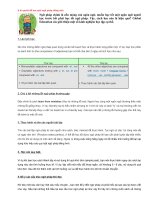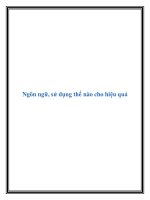Ngữ pháp tiếng anh 6
Bạn đang xem bản rút gọn của tài liệu. Xem và tải ngay bản đầy đủ của tài liệu tại đây (100.25 KB, 6 trang )
Ngữ pháp tiếng anh 6
(Lí thuyết)
1. Để đưa ra lời gợi ý ai đó làm việc gì với mình chúng ta sử dụng các
mẫu câu sau đây:
1.1 Let's + bare infinitive
Ex:
- Let's go to the cinema tonight.
- Let's help her with her housework.
1.2 What about/How about + V_ing....?
Ex:
- What about going to the cinema tonight?
- How about going to the cinema tonight?
1.3 Why don't we + bare infinitive...?
Ex:
- Why don't we go to the cinema tonight?
2. Hỏi giá
2.1 Hỏi giá với "How much...?"
How much + be + noun?
Ex: How much is this pen? (chiếc bút này giá bao nhiêu?)
It is one thousand dong.
How much are books? (Những quyển sách này giá bao nhiêu?)
They are fifty thousand dong.
2.2 Hỏi giá với động từ "COST" (trị giá)
How much + auxiliary verb + noun/pron + cost?
Note: auxiliary verb: trợ động từ
Ex: How much does this pen cost? (chiếc bút này giá bao nhiêu?)
It is/It costs one thousand dong.
How much do these bananas cost? (những quả chuối này giá bao nhiêu?)
They are/ They cost twenty thousand dong.
2.3 Hỏi giá với "What"
What + be + the price(s) of + noun?
Ex: What is the price of this pen?
What is the price of these bananas?
3. Từ định lượng (Partitives)
Đối với các danh từ không đếm được, khi thành lập số nhiều ta phải dùng các từ chỉ định lượng
sau đây. Khi đó số lượng đếm là định lượng từ chứ không phải là danh từ.
Ví dụ: một lít nước (a little of water) thì đó là "một lít" chứ không phải là "một nước"
3.1 a bottle of : một chai
Ex: a bottle of cooking oil. (một chai dầu ăn)
a bottle of wine. (một chai rượu)
3.2 a packet of: một gói
Ex: a packet of tea. (một gói trà)
a packet of cigarettes. (một gói thuốc)
3.3 a box of: một hộp (hộp giấy, bìa)
Ex: a box of chocolates. (một hộp sô cô la)
a box of chalk. (một hộp phấn)
3.4 a kilo/gram/little of: một cân/gam/lít...
Ex: a kilo of beef. (một kilogam thịt bò)
a little of water. (một lít nước)
3.5 a dozen: một tá
Ex: a dozen eggs. (một tá trứng)
3.6 a can of: một lon, một hộp (hộp kim loại)
Ex: a can of peas. (một hộp đậu)
3.7 a bar of: một bánh, một thanh
Ex: a bar of soap. (một bánh xà phòng)
a bar of chocolates. (một thanh sô cô la)
3.8 a tube of: một túyp
Ex: a tube of toothpaste. (một túyp kem đánh răng).
4. Động từ khiếm khuyết: Can và Can't
4.1 Cách dùng (Uses)
"Can" có nhiều cách sử dụng, trong bài "Can" được dùng để chỉ ai đó có khả năng làm gì.
Ex: I can speak English.
He can swim.
4.2 Hình thức (forms)
Là động từ khiếm khuyết nên "Can" có chức năng giống như những động từ khiếm khuyết khác.
(Xem thêm phần động từ khiếm khuyết).
a/- Ở dạng khẳng định:
S + can + bare inf...
Ex: He can drive a car.
They can do this work.
b/- Dạng phủ định, chúng ta thêm "Not" sau "Can". Viết đầy đủ là "Cannot", viết tắt là "Can't"
S + cannot/can't + bare inf..
Ex: He cannot/can't drive a car.
They cannot/can't do this work.
c/- Chúng ta đưa "Can" lên trước chủ ngữ để thành lập câu hỏi
Can + S + bare inf...?
Ex:
Can
he
drive
a
car?
Yes,
he
can/No,
he
can't.
Can they do this work? - Yes, they can/ No, they can't.
5. Giới từ chỉ vị trí (Prepositions of place)
5.1 HERE: Ở đây, tại nơi này.
Ex: We live here.
5.2 THERE: đằng kia, nơi đó.
Ex: It's there, right in front of you.
5.3 INSIDE: ở trong, bên trong
Ex: The guest had to move inside when it started to rain.
5.4 OUTSIDE: ở ngoài, bên ngoài
Ex: Please wait outside.
5.5 UPSTAIRS: ở tầng trên, ở trên lầu, trên gác
Ex: I heard someone talking upstairs last night.
5.6 DOWNSTAIRS: ở tầng dưới, dưới lầu
Ex: They're waiting for us downstairs.
5.7 AT : tại, ở
Ex: We learn English at school.
5.8 AROUND: xung quanh
Ex: There is a garden around my house.
5.9 BEFORE: trước, ở phía trước
Ex: My school is before the park.
5.10 BEHIND: ở phía sau
Ex: The dog is behind the table
5.11 BESIDE: bên cạnh
Ex: The bookstore is beside the drugstore
5.12 BETWEEN...AND: ở giữa...và...
Ex: The police station is between the bookstore and the toystore
5.13 UNDER: ở dưới
Ex: The cat is under the table
5.14 IN FRONT OF: phía trước
Ex: The post office is in front of the lake.
5.15 NEAR: gần
Ex: I live near a river.
5.16 NEXT TO: bên cạnh
Ex: The bank is next to the post office
5.17 OPPOSITE: đối diện
Ex: The bakery is opposite the bookstore
5.18 TO THE LEFT/RIGHT: bên trái/ phải
Ex: There is a well to the left of my house.
There is a flower garden to the right of my house.
6. Giới từ chỉ thời gian (Preposition of time)
6.1 In + tháng/năm/tháng, năm
Ex: In September in 1979 in September 1979
6.2 In + the morning/afternoon/evening (vào buổi sáng/chiều/tối)
Ex: I usually get up at 6 in the morning.
We often watch TV in the evening.
6.3 On + thứ/ ngày tháng/ ngày tháng năm
Ex: on Monday On September 14th on September 14, 1979
6.4 At + một điểm thời gian cụ thể
Ex: at 6 o'clock. She often goes to bed at 11 p.m
6.5 After/before + thời gian
Ex: After 5 o'clock Before 8 a.m
6.6 Between + thời gian + and + thời gian
Ex: I'll wait for you there between 7 p.m and 11 p.m
7. Đại từ sở hữu (Possessive pronouns)
7.1 Các đại từ sở hữu
7.2 Cách dùng
Các đại từ sở hữu được dùng để thay thế cho tính từ sở hữu và danh từ khi chúng ta không
muốn nhắc lại danh từ đó.
Ex: This is my house and that's hers. (hers = her house)
Your pen is blue. Mine is red. (Mine = my pen)
8. Sở hữu với danh từ (possessive case)
Ngoài cách nói sở hữu dùng tính từ sở hữu ra chúng ta còn gặp dạng sở hữu với danh từ. Ví dụ
muốn nói: chiếc cặp của Hoa, cái thước của Lan, chúng ta sẽ sử dụng cách sở hữu với danh từ.
8.1 Thêm ('s) vào sau danh từ thứ nhất không tận cùng là "S"
Ex: the teacher's book. (quyển sách của một giáo viên)
Mr. Tuan's house. (ngôi nhà của ông Tuấn)
The children's school. (trường học của bọn trẻ)
8.2 Nếu danh từ thứ nhất tận cùng là "S" thì chỉ cần thêm dấu (').
Ex: the teachers' book. (quyển sách của những giáo viên)
My boss' car. (chiếc xe hơi của ông chủ tôi)
The girls' schoolbags. (những chiếc cặp sách của những cô gái)
8.3 Đối với danh từ chỉ vật chúng ta thường dùng cách sở hữu với "OF"
Ex: the leg of the table. (chân bàn
The end of the story. (phần cuối của câu chuyện)
9. Tính từ sở hữu (Possessive adjectives)
9.1 Cách dùng (uses): Tính từ sở hữu được dùng để chỉ sự sở hữu của một người hay một vật
về một vật nào đó. Tính từ sở hữu luôn luôn có danh từ theo sau.
Ex: my pen (bút của tôi), her house (nhà của cô ấy)
9.2 Bảng các tính từ sở hữu tương đương với các đại từ nhân xưng.
9.3 Một số ví dụ:
- This is my pen. (Đây là bút của tôi)
- His house is very nice. (Nhà của anh ấy rất đẹp)
- My name is Hoa. What is her name? (Tên tôi là Hoa. Tên của cô ấy là gì?)
- What is your father's job? (Nghề nghiệp của bố bạn là gì?/ Bố bạn làm nghề gì?)
10. There + be... (có)
Chúng ta dùng "there + be" để chỉ sự hiện hữu của một người hay một vật nào đó. Nếu danh từ
theo sau động từ "tobe" ở số ít hoặc danh từ không đếm được thì động từ "tobe" ở số ít. Nếu
danh từ theo sau là danh từ đếm được số nhiều thì động từ "tobe" ở số nhiều.
10.1 There + is/was/has been + singular noun/uncountable noun
Ex:
- There is a book on the table.
- There is some water in the glass.tables in the livingroom.
- There was a car here yesterday.
10.2 There + are/were/have been + plural noun
Ex:
- There are some books on the table
- There are two tables, a television and a radio in the livingroom.
10.3 Ở dạng phủ định ta thêm "not" sau động từ "to be": There + be + not + noun
Ex:
- There isn't a book on the table.
- There aren't some books on the table
10.4 Ở dạng câu nghi vấn (câu hỏi) chúng ta đưa động từ "tobe" lên trước "there". Câu trả lời là
Yes, there + be / No, there + be not.
Ex:
- Is there a book on the table? – Yes, there is./ No, there isn't
- Is there some water in the glass? – Yes, there is/ No, there isn't
- Are there some books on the table? – Yes, there are/ No, there aren't.
11. "Be going to"
11.1 Cách dùng (Use): "Be going to" được dùng để diễn tả một hành động xảy ra ở tương lai có
sự sắp đặt hoặc lên kế hoạch từ trước.
11.2 Hình thức (Forms):
a. Câu khẳng định (Affirmative):
S + be + going to + V....
Ex: I am going to Hue tomorrow.
She is going to Ha Noi this evening.
We are going to the theater tonight.
b. Câu phủ định (Negative): S + be not + going to + V...
Ex: I am not going to Hue tomorrow.
She isn't going to Ha Noi this evening.
We aren't going to the theater tonight.
c. Câu nghi vấn (Interrogative):
Be + S + going to + V...?
Yes, S + be/ No, S + be not
Ex: Are you going to watch TV tonight?
Yes, I am/ No, I am not
Is he going to play soccer tomorrow afternoon?
Yes, he is/ No, he isn't
Ngữ pháp tiếng anh 6 (Bài tập)
PAPER ONE: READING COMPREHENSION A ( 45 minutes )
SECTION A:
In this section you must choose the word or phrase which best completes each
sentence. Circle the letter A, B, C or D against the number of each item 1-20 for the
word or phrase you choose. (20 points)
1.
My
....................
chocolate
candy.
C. with
D. at
2.
I
have
English
....................eight
months.
A. for
C. by
D. in
3.
Listen
....................our
teacher
!
A. with
B. to
C. for
D. in
4.
There
isn’t
....................food
in
the
house.
A. none
B. no
C. some
D. any
5.
He
arrives
…………………..at
six
o’clock.
A. at home
B. home
C. in home
D. to home
6.
Herbert
has
had
his
car…………………..
1999.
A. ago
B. since
C. to
D. for
7.
How
long
will
it
....................to
get
there
?
A. cost
B. lose
C. make
D. take
8.
I
....................it
to
you
if
you
don’t
have
one.
A. give
B. gave
C. will give
D. would give
9.
....................your
homework
yet
?
A. Did you finished
B. Are you finishing
C. Do you finish
D. Have you finished
10.
It’s
the
best
book
I
…………………..read.
A. have ever
B. had ever
C. will ever
D. can ever
11.
He
looked
very..................when
I
told
him
the
news.
A. happily
B. happy
C. happiness
D. was happy
12.
She
is
..................in
history.
A. interests
B. interested
C. interesting
D. being interest
13.
Is
the
Eiffel
Tower
taller....................Big
Ben
?
A. then
B. than
C. as
D. of
14.
At
school,
David
was..................anyone
else
in
his
class.
A. as clever as
B. as clever than
C. cleverer as
D. cleverest
15.
She
speaks
French
....................than
you.
A. more faster
B. more fluently
C. well
D. the most fluently
16.
It
began
to
rain
while
we…………………..soundly.
A. slept
B. were sleeping
C. have slept
D. are sleeping
17.
She
doesn’t
like
coffee,
does
she
?
A. Yes, she doesn’t
B. No, she does
C. Yes, she did
D. No, she doesn’t
18.
I
won't
go
to
bed
…………………..I
finish
my
homework.
A. until
B. when
C. while
D. since
19.
Is
this
book
…………………..
?
Yes,
it's
mine.
A. you're
B. yours
C. you
D. your
20.
…………………..do
you
come
to
school
?
By
bus
A. How
B. What
C. By
D. When
SECTION B:
In this section you will find after the reading passage a number of questions of
unfinished statements about the passage , each with four suggested answers or
ways of finishing . You must choose the one which you think fits best (10 points)
People usually sing because they like music or because they feel happy. They express their
happiness by singing. When a bird sing, however, its song usually means much more than that
the bird is happy. Birds have many reasons for singing. They sing to give information. Their songs
are their language.
The most beautiful songs are sung by male (cock) birds. They sing when they want to attract a
female (hen) bird. It is their way of saying that they are looking for a wife.
Birds also sing to tell other birds to keep away. To a bird, his tree or even a branch of tree, is his
home. He does not want strangers to come near him, so he sings to warn them.
If a bird cannot sing well, he usually has some other means of giving important information. Some
birds dance, spread out their tails or make other sings. One bird has a most unusual way of
finding a wife. It builds a small garden of shells and flowers.
A. of
sister
is
very
B. about
studied
B. since
fond
21.
Why
do
people
usually
sing
?
A. They like birds.
B. They feel happy.
C. They want to tell a story .
D. They like studying music.
22.
Which
birds
sing
the
most
beautiful
songs
?
A. Birds in a good temper.
B. Cock birds.
C. Hen birds.
D. Female birds which attract male birds.
23.
What
warnings
does
a
bird
sometimes
sing
?
A. A warning to keep away.
B. A warning to come quickly.
C. A warning about the approach of people
D. A warning to stop singing.
24.
What
do
most
birds
usually
do
if
they
cannot
sing
well
?
A. warn other birds to go away.
B. give their information in another way.
C. find a wife.
D. fly high in the sky.
25.
What
is
one
bird's
unusual
way
of
attracting
a
hen
bird
?
A. It dances.
B. It spreads out its tail.
C. It searches for a wife.
D. It uses shells and flowers to make a
garden.









